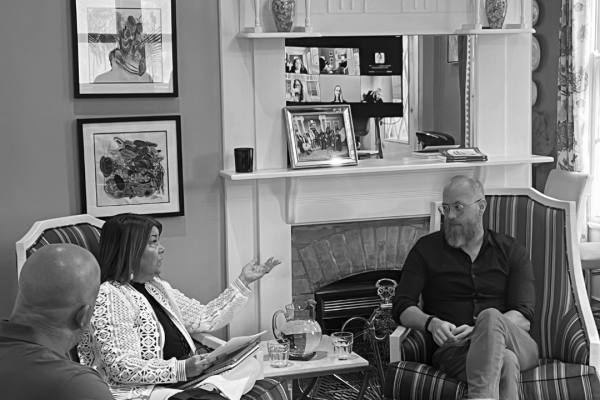If you work in financial services and technology, chances are you’ve read an article written or edited by Steve Cocheo. A more than 40-year veteran of the journalism industry, Steve is the award-winning senior executive editor for The Financial Brand, a digital publication focused on marketing and strategy issues affecting retail banks and credit unions. Coverage at the intersection of banking and marketing? Of course we’re fans.
I’ve had the pleasure of collaborating with Steve since his time at Banking Exchange, which he co-founded and where he served as executive editor for nearly four years. His decades of experience before then included more than 35 years at the ABA Banking Journal. When I think of financial technology and compliance experts, I think of Steve.
For our “A conversation with” series, Steve shows us how deep his banking expertise goes—with bylines covering every major financial crisis since the 1980s—tells us about his PR red flags, and imagines a historic round-up of dream interviewees.
Emma Chase (EC): How did you get your start in journalism?
Steve Cocheo (SC):
I was extremely fortunate to have had many opportunities to report and write for off-campus publications before and during college. I couldn’t have asked for better opportunities, though school papers taught me a good deal, too. I wrote news and features for a local weekly, the Levittown Tribune, after the editor offered me the chance to work for experience. Between that job in late high school/early college and my graduation, I had two internships at Newsday, a campus stringer position with The New York Times, and a part-time job on a business magazine, Dun & Bradstreet Reports.
The latter magazine went to credit managers who used D&B’s business credit reports. When I started doing job interviews, the editor of ABA Banking Journal spotted a stray mention in one of my credit articles about what was then (1979) the new bankruptcy law. He asked me to do a freelance piece about it.
That handful of words he’d spotted was all I knew about bankruptcy law. Being young and overconfident, I said yes, believing I could tackle anything. I learned a lot about banking and myself in the process of starting that article as a freelancer and then finishing it a couple of months later as an employee. I nearly got fired before I completed the piece and then the boss understood why it was so hard.
I have been covering banking ever since and am still learning. The year I started was the beginning of a very interesting period in the industry’s history that hasn’t stopped.
EC: In your words, what makes a good story?
SC:
I like stories that tell stories best. I’d rather read, and write, about how a bank or banker met a major challenge than a story about a study. But I also like “explainers,” especially when doing the piece means learning about the matter myself and then sharing it. Solid roundups that go into some depth mean much to me as a reader and I enjoy doing them as a writer. In everything, I like context and strive to put it into my own articles.
What’s a good story for The Financial Brand? Ask yourself if you would read it to the end if it didn’t involve a client.
EC: What’s your biggest pet peeve as a journalist?
SC:
Too many PR people pitch me without knowing anything about my publication. With everything we do available on the web without a paywall, there’s no excuse for not knowing much that could be learned by spending an hour perusing the website.
A runner-up: Pitches or guest posts that contain out of date data.
One more: Follow-up calls or emails the same day the initial contact was made.
EC: What story are you most proud of in your career so far?
SC:
It’s hard to say because I’ve been fortunate to enjoy my work for my entire career. Anything that requires a lot of digging really appeals to me. But one especially stands out.
Walmart has been trying to get into financial services for decades. It keeps trying new paths in. I did a major analysis of this a while back—”Walmart: Partner or Competitor?” The print article included a magazine spread consisting of a “Walmart in Banking” game of chutes and ladders, showing everything the retailer had tried up until then, with little Walmart characters as game pieces. It was a hit with our readers and earned me a finalist spot in the Jesse Neal National Business Journalism Awards. But most of all, I had a blast working away at the story.
EC: What story do you wish you could have covered?
SC:
I have written, in one way or another, about nearly every banking crisis since the savings bank debacle of the early 1980s. I only say this to put my answer in context. I would have liked to have covered the aftermath of the Crash of 1929, especially the development of much of the bank regulatory system that we have today.
EC: What famous historical figure do you wish you could have interviewed and why?
SC:
It would be a toss up among five people: Franklin Delano Roosevelt, Winston Churchill, Theodore Roosevelt, Rudyard Kipling and Mark Twain. Better yet, a roundtable discussion, complete with fine cigars and brandy.
Why? Tremendous admiration for each and the opportunity to see the real men beyond the legends or the clichés.
EC: What are some of the biggest banking and fintech trends you anticipate covering this year?
SC:
That’s a tough one. Commercial real estate, the future of fintech, and artificial intelligence are three prime stories.
I feel more than usual will hinge on the elections, in terms of the direction of the economy and of regulation, legislation and policy of banking and fintech. I covered federal affairs for a good many years. Banking regulation has never been free of politics, in spite of what some say. But in recent years it has become sticky with politics. Both likely candidates have track records in this regard and whoever wins, what follows will dictate the future of both banking and fintech.
Either way, it won’t be pretty.





